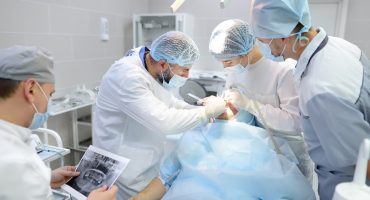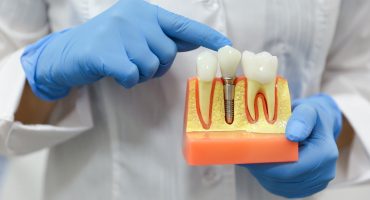Braces belong to the medical aids. They serve the correction of malocclusions and malpositions of the jaw. The treatment and medical care is provided by your dentist or an orthodontist. Braces are most commonly used in children during the tooth growth phase. As an adult, however, they also have the option of correcting existing malocclusions with a brace, even in combination with an existing dental implant.
Benefits of braces
The reasons for a brace are many and varied, ranging from the medical need due to malposition of teeth or jaw to purely cosmetic causes. The actual requirement from a medical point of view determines your doctor on the basis of certain orthodontic indication groups (KIG). This is done before the start of a treatment and serves to classify the treatment needs.
Among other things, the tooth distances are measured or a crossbite is detected, in which the teeth in the lower jaw bite from the outside in front of the teeth in the upper jaw. A purely optical restriction in relation to the teeth and the dentition is usually not sufficient for a medical indication.
There is a concrete need, above all, if existing problems are related to a malformed tooth or jaw. For example, if you have specific malfunctions in the area of chewing and swallowing, this is often an indication for braces. Other reasons include errors in speaking, pain or difficulty breathing. In addition, the possibility of a future negative development of the tooth position usually defines a treatment.
Different types of braces
There are several variants of braces, which differ from each other mainly by fixed and removable models. Fixed braces consist of several components, which are referred to as multi-band apparatus. The components include brackets, rubbers and bows. The brackets are special brackets made of ceramic or metal, which your doctor fixes on the teeth with a special adhesive. Small devices, so-called slots, allow the attachment of rubber or bows. They are adjustable and determine the orientation of the tooth position. Fixed clips remain in the mouth for about 18 months.
Removable braces, also referred to as loose braces, allow you to remove and replace them yourself. The product consists of active plastic plates that your orthodontist attaches to the jaw by means of clamps. In addition, fittings and springs made of wire allow a gradual correction. The removable braces are at least worn for 15 hours daily. Ideally, removal is for food or sporting activities only. The clasp is easy to clean and comes after removal in a braces Dose for safekeeping.
Areas of application and therapeutic application
The use of different types of braces depends on the diagnosis of malposition. Fixed braces are helpful if there are particularly pronounced misalignments. The treatment of a larger number of teeth or groups of teeth is best solved by a fixed braces. A regular check and the associated adjustment of bands and bows allow a very precise adjustment and treatment. A careful oral hygiene and dental caries is a prerequisite for the use of a fixed clip. This includes the regular professional cleaning of teeth in the rooms of your dentist to exclude damage to the teeth. Loose clasp models have the advantage that they are used at a very young age, even in the milk teeth dentition.
Braces are always made individually. On the basis of X-rays and impressions a model is made as a template for the clasp. With a loose clasp, your doctor will show you the correct insertion and removal. You will be informed about the best type of oral care and frequency of visits for all types of braces.
A brace to correct dental and jaw deformities is suitable for children and adults. Also for purely esthetic reasons, a treatment is possible. For the therapy fixed and loose clasp models are suitable. For dental implants, the use of braces is also possible. Your orthodontist will be happy to advise you.
Adult Braces
The treatment of adults is highly dependent on individual age. The higher the age, the less a brace influences the growth of the teeth. Instead, the movement of the teeth in the jaw is made by the specific pressure, which is responsible for the removal and development of the jawbone. Nevertheless, you will benefit from braces even in adulthood. The older you are, the longer this usually takes the treatment.
The causes of using an adult clasp are very different. Often it concerns purely esthetic motives, which are not considered by the health insurance companies with the reimbursement. Nevertheless, if you have the desire for an optical improvement of your teeth, a treatment is always open to you. Often, however, there are also malocclusions that justify a brace from a medical point of view. These include missed childhood correction or late problems, such as wisdom teeth or tooth wandering.
Unlike children, adults attach great importance to the greatest possible inconspicuousness when using braces. The invisible incognito braces an option or an aligner therapy in the form of a plastic splint that is transparent.
Costs for the treatment with braces
The costs for a brace are reimbursed by the health insurance company for legally insured persons. The prerequisite for this is a medical indication that can be determined by an orthodontic physician or dentist. For this purpose, a corresponding expert advice is provided, which informs about the treatment options and the braces in question.
It is often possible to choose a brace, the cost of which exceeds the benefits of statutory insurance. Patients have the opportunity to bear the additional costs themselves and to use such a brace. The exact costs depend on the type of treatment and the used clip and are composed of the material and laboratory costs as well as the medical fee.
Weitere Beiträge
Issue Amalgam Tooth Fillings
If there is a hole in the tooth, the drill must first be used. Subsequently, however, the question arises with which material the hole in the tooth should be filled. In addition to various restoratives, Amalgam- a classic in the field of dental care, is available for selection.

Distraction
Before an implant, i.e. firmly anchored dentures, can be used, there are preparatory measures for the intervention of the implantologist. Distraction osteogenesis or callus distraction is an operative procedure in the field of oral and maxillofacial surgery for new bone formation.


